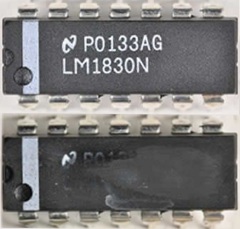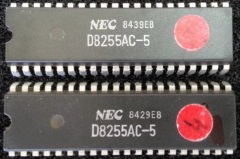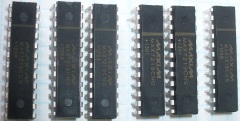|

University of Connecticut Paper on Counterfeit Integrated
Circuits
| This paper, developed by the Center for Hardware
Assurance, Security and Engineering at the
University of Connecticut and published in the
Journal of Electronic Testing: Theory and
Applications, discusses the dangers of counterfeits
and some techniques to identify and avoid them. The
paper appears to have been removed from the UConn
website, but can be downloaded from
here. |
Background
This page was inspired by the problems that Martin
experienced when testing his version of the MTXPlus+
CPU Board. We had intended
to use the 20MHz Z80 CPUs that we had been given by Lez
Anderson, clocked at 16MHz for compatibility with the RAM and
ROM chips that Lez had also donated.
However, Martin was unable to get either of the two
processors that he tried to run reliably above 10 MHz, whereas
he was able to significantly over-clock a 10MHz Z80 CPU obtained
from Mouser Electronics to
20MHz and beyond. This made Martin wonder whether the CPUs were
really 20MHz after all.
The maximum speed of an
NMOS Z80
is 8MHz for a Z80H CPU, other available NMOS CPUs are Z80B
(6MHz), Z80A (4MHz) and the original Z80 (2.5MHz). Using
the CMOS Z84C00
range, DIP packaged chips with speeds ranging from 4MHz to 20MHz
are available, including the 20MHz Z84C0020PEC that we had
intended to use.
I did a bit of "Googling" and found a method of determining
programmatically whether a Z80 was an NMOS or CMOS version. The
basis of this method was described in a
Usenet posting
by Simon Cooke in 1996,
Google
Groups hosts an archive of Usenet posts,
including this one.
With an NMOS Z80, an OUT (C),0 instruction outputs 0,
with
a CMOS Z80, OUT (C),0 outputs FFh. Martin used this
information to run tests on a number of Z80 CPUs that he had to
hand, which gave the results shown :
| Chip ID Label |
Logic |
Rated
Speed |
Max
Speed
Achieved |
Out (0), 0
Test Result |
| NEC D70C |
NMOS |
2.5 MHz |
4 MHz |
&00 |
| Zilog Z80A |
NMOS |
4MHz |
8 MHz |
&00 |
| Zilog Z84C0010PEC |
CMOS |
10 MHz |
> 20 MHz |
&FF |
| Zilog Z84C0020PEC |
CMOS |
20 MHz |
10 MHz |
&00 |
| Zilog Z84C0020PEC |
CMOS |
20 MHz |
10 MHz |
&00 |
From the very limited testing, it can be
seen that the 10MHz CMOS chip performed exceptionally and the
NMOS chips all performed above their rated speed. The "20" MHz "CMOS"
chips on the other hand were very disappointing, the test values
indicating that they were actually NMOS chips and given the maximum
operating speeds achieved, were more than likely actually Z80H
components.
The Bigger Picture
I guess we are all aware of the dangers associated with
buying components from China through the likes of eBay, but for
the casual hobbyist, the potential cash savings mean that the
risks are probably worth taking. In fact, even multi-national
corporations, the US government and NASA are not immune from
being affected by counterfeit components. The situation is not
helped by the component manufacturers efforts to drive down
costs by out-sourcing the manufacture of genuine components to
China.
The two most common methods of "counterfeiting" integrated
circuits are excess production and "blacktopping".
Excess Production
Even when manufacturing in low cost centres such as China,
the component designers drive the unit costs as low as possible.
It is apparently not uncommon for the component factories to
overproduce components in excess of the original order and
market them through the
grey market.
Though probably not subject to the same quality control and
testing as the official production run, such items are at least
manufactured to the same design and specifications as the
original.
Blacktopping
This is the more common way of counterfeiting components and
almost certainly what has been done with the "20" MHz CPUs that
we have. In this technique, the top surface of the chip is
removed and a new "black top" coating applied to obscure the
original manufacturing part number and date code. A replacement
ID and date code is then reapplied by either painting or laser
etching the new surface.
In this way, for example, genuine Zilog Z80H NMOS chips can
be remarked as CMOS components with higher speed ratings which
sell at higher prices. The price differential is illustrated by
the prices Martin found for different speed ratings of CMOS
components on the Mouser website:
- Z84C0006PEC = £2.84 + VAT
- Z84C0008PEC = £2.84 + VAT
- Z84C0010PEC = £2.84 + VAT
- Z84C0020PEC = £6.94 + VAT
Beating the Counterfeiters?
So, how can you protect yourself from being caught out by
counterfeit chips? The standard response from the semiconductor
companies is to "always buy from approved suppliers", but whilst
the incidence is much less common, buying from an approved
supplier is not a guarantee that you will be getting genuine
components.
As illustrated above, it may be possible to test the
components to determine whether or not they are genuine, but
this is only likely to be an option in a very limited number of
cases. The majority of the time, the only method of identifying
counterfeits is visually - which is becoming more difficult as
the fakes get better.
Some tips for Identifying Fakes
By the time that you receive the components it will likely be
too late, but you may find this information useful. Some examples of possible indicators that the chips are not
what they appear are shown below, for much more information on
the subject, including detection of counterfeit integrated
circuits, see the references at the bottom of the page.
|
The Good, the Bad and the Ugly |
| By way of example of a genuine part,
this is an older generation Zilog Z80 DART. Note
the clear cut edges of the circular mould marks on
the top and bottom. The photo does not do it
justice, but the manufacturing location, in this
case, the Philippines, can be easily read in one of
the bottom mould marks. |
 |
|
 |
| And now, with the
benefit of hindsight, some of the counterfeit
Z84C0020PECs that we have seen - you probably need
to click on the image to open it full size to see
the detail |
| Here, the mould marks are visible -
just, but they have very little depth, removal of
the original chip markings has reduced the thickness
of the top layer of plastic so the marks are now
barely visible. However, the bottom of the chip
looks as good as the genuine part, but this is to be
expected if the counterfeiter had used a genuine
Zilog NMOS CPU to fake the CMOS part. |
 |
|
 |
| In this one, the mould marks are
totally absent on the top side. On the bottom of
the same chip, even though the mould marks are
present, there is no embossed text to denote the
country of manufacture. |
 |
 |
| In this one, the mould marks are present but are
not clean and have been contaminated by the
remarking process. Mould marks on genuine chips will
always have clearly defined edges. |
 |
| This photo was downloaded from
cpu world.com to show the logo of a
(hopefully) genuine Zilog CPU |
 |
| I don't know if this is a good indicator, but
the logo on this Z84/20 looks subtly different to
the one from CPU World. The font used for "ZILOG"
appears to be slightly heavier and the tails of the
"Z" logo appear to be more angular than the slightly
rounded ones from CPU World. |
 |
| All of the suspect components we have, have the
Zilog name printed in upper case, genuine components
use a lower case "i", i.e., "ZiLOG" as
opposed to "ZILOG" |
 |
| Even though all of the
components had the same date code (0512), the bottom
mould marks showed a number of different countries
of manufacture, including Philippines, Malaysia and
Indonesia, as well as some showing no information at
all. This is not a good omen, according to
American Electronic Resources Inc,:- "We
have done investigations with the component
manufacturers and all of them we have spoken to say
that a part with the same lot code as another cannot
be manufactured in different countries" |
| And finally, having had a quick look on ebay,
here is a familiar looking chip, it even has the
same date code - seller's logo removed so as not to
cause offence - or more importantly, get me into
trouble for making potentially false accusations.
So, would you buy one of these now? This component has an index
mark at pin 1 which is not present in our examples
or in any other photos of the chip that I have seen on the web, apart
from on ebay, or on any of the Z80 CPUs that Martin
and I have.. |
 |
These are just a few examples of some of the things that you
might look for, other give-aways include the resistance of the
markings to solvents. There is a lot of information available on the
web that can give you additional tips for spotting fake
components. For example, Google "counterfeit
integrated circuits" or "blacktopping
integrated circuits". Alternatively, follow the links to the
references at the bottom of the page.
|
More examples of counterfeits |
| An example of the use of solvent to expose the
substandard markings on a fake chip. No prizes for
guessing the fake in this photo.
Photo from SMT
Corporation |
 |
| An example of a genuine part alongside a
counterfeit. From
eeweb.com |
 |
| Examples of genuine and fake MAX7219 display
controllers From
tronixstuff.com |
 |
| Some "Must See"
Photos . . .
This is a comparison of genuine and cloned FTDI
USB serial port chips, for really great die photos
of what's inside the two, see the
Zeptobars site
detailed discussion here. |
 |
| |
|
References :
Simon
Cooke, Usenet 1996, post about the "Z80
OUT (C), 0" instruction
University of
Connecticut Paper on
Counterfeit Integrated Circuits
Identifying counterfeit components
Emphasis Tech Tip
Counterfeit Electronic Component Detection,
www.erai.com
Counterfeit Integrated Circuits: Detection, Avoidance, and the
Challenges Ahead
www.erai.com
Methods Used In The Detection Of Counterfeit Electronic
Components, Harold Hewett, Electro-Comp Services, Inc
Component markings - solvent Resistance,
US
MIL-STD-883G METHOD 2015.13 18
Awareness of Marking Permanency and Black Top Testing in Today’s
Electronic Component Industry, New Jersey Micro Electronics
Testing Inc
Facing the Counterfeit IC Issue, EEWeb.com
The Hidden Dangers of Chop-Shop Electronics,
www.ieee.org
Counterfeit Examples Electronic Components,
Components Technology Institute
- A very interesting slide pack with good example photos
|